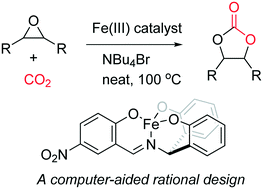Computer-aided rational design of Fe(iii)-catalysts for the selective formation of cyclic carbonates from CO2 and internal epoxides†
Abstract
The catalytic mechanism of the cyclic carbonate formation reaction between CO2 and internal epoxides promoted by Fe-salen and the Kleij catalyst was examined in detail to better understand how the catalytic efficiency can be increased. Specifically, we aimed to make the catalyst more chemoselective towards forming cyclic carbonates and preventing the competing side reaction leading to polycarbonates via ring-opening polymerization. A few rational design principles were derived and first tested using computer models based on density functional theory. The most promising candidate that was identified in the computer model was then prepared and found to display significantly enhanced reactivity towards forming the cyclic carbonates, supporting the validity of the mechanistic insights deduced from the computer simulations. We propose that a cyclic carbonate is formed most efficiently via an inner-sphere mechanism where both the CO2 and epoxide substrates utilize the metal center for the key bond forming events. In contrast, the ring-opening polymerization uses an outer-sphere mechanism, where a carbonate attacks and ring-opens the epoxide bound to the metal without engaging the metal directly. These mechanistic differences are exploited to implement a chemoselective catalyst by enhancing the rate of the cyclic carbonate formation reaction while leaving the polymerization pathway largely unaffected.

- This article is part of the themed collection: 2017 Catalysis Science & Technology HOT Articles


 Please wait while we load your content...
Please wait while we load your content...